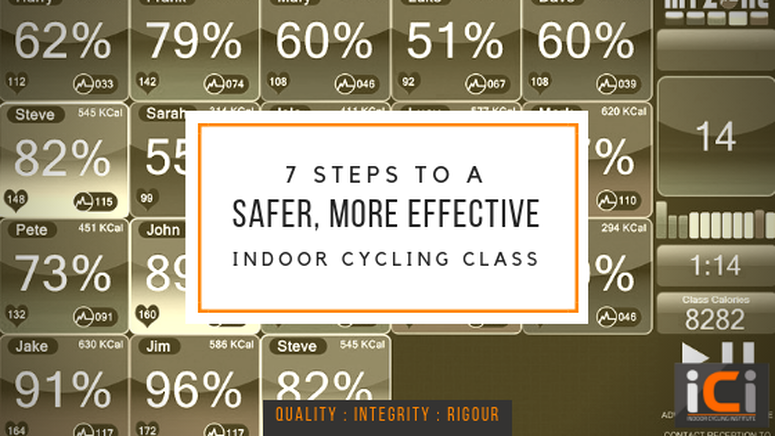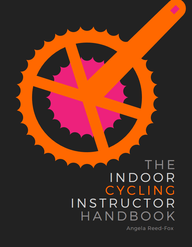by Angela Reed-Fox 7 steps to a safer, more effective indoor cycling classYou'd think that'd be so easy everyone would be doing it, right? Well when we recently updated our entry level 2 day indoor cycling instructor course, we include a bit on litigation (because if you need your insurance, you're too late!) and as part of this we research court cases being brought against cycling studios and gyms, and we look for patterns in the reasons for the litigation, and who is being blamed. In more than 95% of recent cases (in the last five years) it's due to instructor error - instructors have either given poor instruction or have had riders doing unsafe moves. Incidentally the remaining 5% of cases is due to either the studio being too dark for riders to see what they're doing, or equipment being poorly maintained or with sharp prominences. What does this mean for you as an indoor cycling instructor? It means that there's a lot you can do to reduce the risk of injury for your riders, and litigation both for yourself and your venue. Here's how: Injury check There are three points at which each rider should be asked about injuries, health issues or concerns:
Bike setup All new riders need a bike setup - this is the perfect opportunity to answer any questions they have and help them feel comfortable. A suitable bike setup will reduce aches and improve comfort. Riders will be able to ride more efficiently, using more of the larger muscle groups as they pedal. This improves the calorie burn and the training effect. Consider jotting your riders' bike settings on record cards which they can refer to at their next session and have a go at setting themselves up. Think about data protection though and make sure you destroy old cards. Clear instruction In the interests of safety and effectiveness, this is essential. Riders need to know what you're asking them to do, as well as how. For a bonus point, you can also tell them why it's good for them! There are five main points you'll need to give them for each challenge:
Be kind, and don't forget to cue them in and cue them out. Safe cadence Cadence is a biggie when it comes to rider injuries. Safe cadence also requires safe resistance. What we need to particularly guard against is crazy high cadence with insufficient resistance . Not only is this totally ineffective, but it increases the risk of the rider losing control of the pedals. (Remember, the bike has a fixed wheel.) So, stick to a safe cadence range. We don't recommend going lower than 60rpm. Obviously it's possible to pedal slower than this, but what tends to happen at this point is that riders either don't have sufficient resistance to be pedalling effectively, or they have so much on they're unable to pedal any faster and are overloading their joints. We don't recommend going higher than 120rpm. But in fact, when we're instructing, we tend to encourage riders to add more resistance if they're reaching 120rpm, which will then bring their cadence down. Yes, it's possible to pedal that fast with riders who are experienced and have good coordination. However, you'll frequently see terrible technique starting to creep in when you reach this point, which decreases effectiveness, so I'd recommend avoiding going past this point with any riders, however experienced. Always give a cadence guide and let riders know how it should feel as well. Bouncing bottoms in the saddle are a dead giveaway - as are bikes that start squeaking when they're being pedalled fast with no resistance! It's OK to say "If I can hear your bike, you need to add on!" Avoid banned moves We have a list of banned moves. We strongly recommend that venues do this too, either by using ours or creating their own. We ban a move either because it's ineffective and therefore pointless, or because it's downright dangerous. Examples include:
Measurable progress How do riders know they're getting fitter? Remember that a lot of your riders are not in your class purely for enjoyment - they want and need results. What will you do? We recommend using power training so they can see measurable results. If we go by how we feel, this is too subjective and we'll get demotivated quickly. On the other hand, if we can point to actual quantifiable improvements, we're more likely to stay motivated as we can see our effort paying off. Ask us about our power training courses. Heartrate training Using heartrate training in classes is safer. Riders can get to know better how their bodies respond to activity, they know when they need to take it easier than usual, and when they can start pushing harder. They'll be able to detect when they might be overtraining, and they'll be able to stay within safe parameters as each session becomes tailored to them. Not only all this, but we've spotted instances of riders having anomalies which after medical investigation showed conditions being diagnosed such as atrial fibrillation and also blockages of arteries which led to surgery. So there we go - seven ways you can make your classes safer and more effective. Want help or advice on instructor practice or MyZone heartrate training? Get in touch - we're here to help you. Indoor cycling instructor? Click below for free CPD resources. Your venue can also receive information on how we can help improve customer registration, retention, engagement and profitability.
0 Comments
Leave a Reply. |
Categories
All
|
Quick links
Get started
|
Find what's right for you
|
Courses
|
Further learning
|
More
|
The Indoor Cycling Institute provides the most comprehensive and up to date indoor cycling instructor training; providing entry-level courses, and further education to raise the standard of instructors.
© 2014-2024 Protheorem Ltd
The Indoor Cycling Institute is owned and operated by Protheorem Ltd Registered in England & Wales, Company number 12812092
The Indoor Cycling Institute is owned and operated by Protheorem Ltd Registered in England & Wales, Company number 12812092




